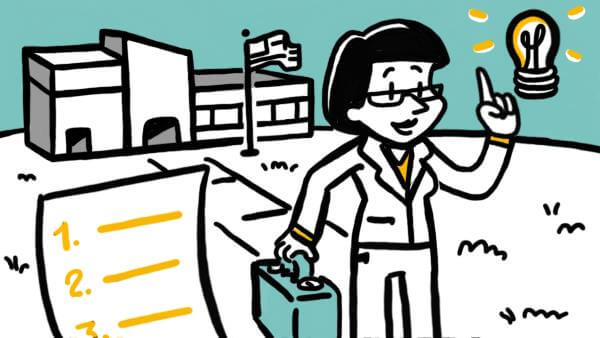Sam Seidel, Director of K12 Strategy + Research at the Hasso Plattner Institute of Design at Stanford (also known as the Stanford D.School), gets at the very heart of design thinking in education when he describes educators’ desire to meet student needs.
“I’m doing this because it’s what my students need,” he hopes to hear, instead of educating in hopes of seeing sufficient test scores and trying out initiatives “imposed on us by the district”. That emphasis on needs is foundational to design thinking. And it is one of the key reasons why design thinking is bringing positive change to education.
While education in a workplace setting is markedly different than K12 education, the application of design thinking to the process yields similar benefits in each arena. Let’s start by looking at what design thinking’s focus on empathy can do for education in the workplace.
Step 1: Start with Empathy
The first step of design thinking is to put yourself in your audience’s shoes. In this case, try to take the perspective of the workplace learner.
As that learner, what do you expect to get out of this workplace training effort? What do you hope to get? What might distract you, or cause you to tune out?
Step 2: Define the Problem
Next, you’ll want to define the problem. This is where the questions you’ve asked yourself about distractions and tuning out will help. When you identify barriers to success, you get closer to defining the exact problem in your workplace education that you’ll be fixing through design thinking.
Steps 3 and 4: Ideation and Prototyping
The next two steps, ideation and prototyping, immerse learners in real-world problem-solving. Design thinking allows rapid, hands-on responses to defined problems. From these prototyping and testing exercises, learners get a better picture of their own abilities. They see grounded applications of otherwise intangible concepts.
These exercises also provide a chance to make mistakes, which is invaluable for employees and students alike. Learning from mistakes will teach employees not to fear taking reasonable risks, and will promote more innovation in their work.
Step 5: Challenge Assumptions
Empathy, problem definition, ideation and prototyping are all crucial to utilizing design thinking. Another one of design thinking tenets might be equally relevant to learners: challenging assumptions. Employees trained to challenge assumptions will be less concerned with ‘tradition’ and more concerned with real-world considerations.
If one of your company’s conventional approaches would contradict a client’s need or desire, it’s important to have employees who can recognize the need to challenge that approach, and come up with a better one based on the client.
Challenging assumptions goes far beyond company procedures. It teaches learners to question their own prejudices and expectations about clients, their coworkers, and their role. Internally, using design thinking to educate trainees on challenging assumptions can change their thinking about their future with the company.
Employees who might’ve first thought of their positions as having limited or no advancement possibilities might, after challenging that belief, realize the opportunities for growth available to them. This can lead to higher employee retention, satisfaction, and loyalty.
Design Thinking Focused on the Learner
Design thinking is a way to counteract the non-creative tendency of conventional education. “Education today is not only not promoting creativity, it’s killing it,” writes Samuel Tschepe. Describing educational design as entirely concerned with transmitting ‘manageable bundles’ of information into the minds of learners, Tschepe offers design thinking as a model with a different goal.
Design thinking in workplace education isn’t centered around information and its transference, but around learners.
The fact that no two learners are the same is why alternative and adaptable (read: creative) thinking is required to truly address learner needs. Design thinking should teach creativity to learners, but it should also promote creativity in educators. One cannot apply a one-size-fits-all approach to any educational setting and still be reasonably called ‘empathetic’ or ‘creative,’ after all.
Creative confidence, one of the traits Tschepe identifies as a product of design thinking in education, is what will allow learners to comfortably experiment, and do so again on the job. Adaptability will keep them challenging assumptions and modulating their work and communications based on client needs or other factors. And the empathetic core of design thinking will leave learners with a better social and cultural awareness, making their interactions with all types of people easier and more genuine.
Step 6: Testing
Finally, design thinking’s last step—testing—teaches learners more than just the importance of experimentation and learning from mistakes. It teaches the value of collaboration. Products and services are not rolled out in a vacuum, or by one person; teach employees early about working together by using design thinking in your educational experiments.
Encourage them to develop and then try out their prototypes, together. Have them give each other feedback, and work to improve team members’ work. The last step of design thinking will reinforce the value of alternative perspectives and working together, and will prepare learners for a collaborative workspace.
Design thinking in education is about starting from an empathetic goal: how can we best meet learners’ needs? With this focus, learners will get a better understanding of their clients’ needs, hands-on experimentation, and much more. They’ll be more confident, loyal team members with a better understanding of collaboration and risk-taking.
How does your organization pursue education?
Have you employed any of the tenets of design thinking?
Do you think your organization would be helped by the empathetic approach?
How might you get started using design thinking in education?

